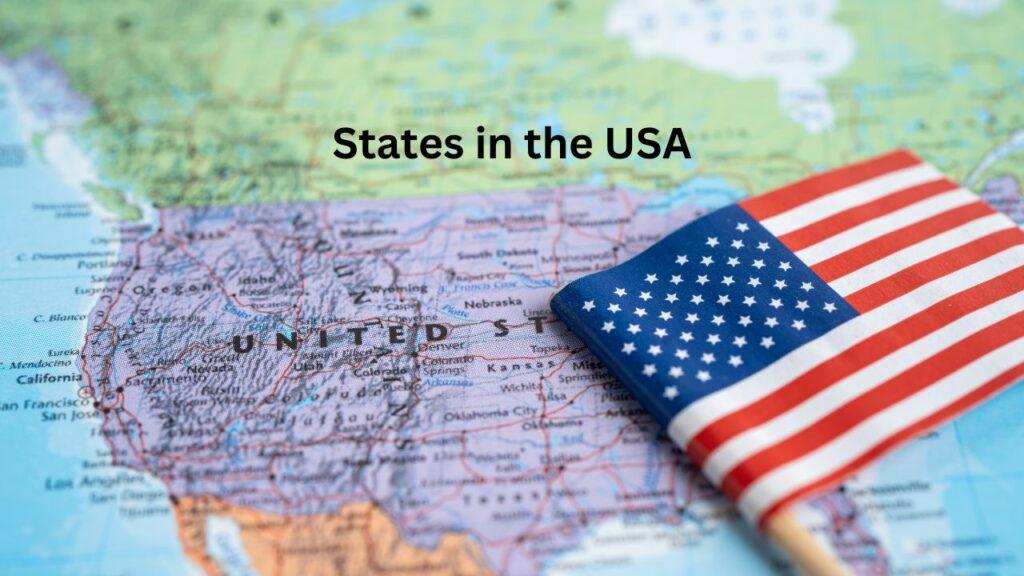States in the USA are the main political and administrative units of the country, each with its government, laws, and rights. The United States of America is a federal republic that consists of 50 states and the District of Columbia. Each state has its history, culture, identity, and government, but they are also united by a common constitution, law, and national interest. This article will give you an overview of the states in the USA, their history, size, and population.
History of States in the USA
History of the states in the USA can be traced back to the original 13 colonies that were established by British settlers along the Atlantic coast in the 17th and 18th centuries. These colonies declared their independence from Great Britain in 1776, after a series of conflicts and grievances that led to the American Revolution.
The colonies then formed a confederation of sovereign states under the Articles of Confederation in 1781. However, this system proved to be ineffective and unstable, so the states decided to create a new constitution that established a federal system of government with a balance of powers between the national and state levels.
The new USA constitution was ratified by all 13 states in 1789, and George Washington became the first president of the United States of America.
Events and Factors that Shaped the States in the USA:
The formation and expansion of the states in the USA were influenced by many events and factors over time, such as wars, treaties, purchases, annexations, and admission acts. Some of the major events and factors that shaped the states in the USA are:
- Louisiana Purchase in 1803, doubled the size of the United States by acquiring a vast territory from France that stretched from the Mississippi River to the Rocky Mountains.
- Mexican-American War in 1846-1848, resulted in the United States gaining more land from Mexico that included parts or all of the present-day states of California, Nevada, Utah, Arizona, New Mexico, Colorado, and Wyoming.
- Civil War in 1861-1865, was a conflict between the northern states (the Union) and the southern states (the Confederacy) over the issues of slavery, states’ rights, and territorial expansion. The war ended with the defeat of the Confederacy and the preservation of the United States as one nation.
- Alaska Purchase in 1867, added Alaska as a territory of the United States by buying it from Russia for $7.2 million.
- Hawaii Annexation in 1898, incorporated Hawaii as a territory of the United States after a group of American businessmen overthrew the Hawaiian monarchy.
- Admission Acts in various years, granted statehood to different territories or regions after they met certain requirements and conditions. The last two states to join the union were Alaska and Hawaii in 1959.
List of States in the USA
The table below shows the states in the USA in alphabetical order, along with their abbreviations, capitals, nicknames, and dates of admission to the union. The list of all the states in the USA are as follows:
| State | Abbreviation | Capital | Nickname | Date |
|---|---|---|---|---|
| Alabama | AL | Montgomery | The Yellowhammer State | January 3, 1959 |
| Alaska | AK | Juneau | The Last Frontier | February 14, 1912 |
| Arizona | AZ | Phoenix | The Grand Canyon State | February 14 , 1912 |
| Arkansas | AR | Little Rock | The Natural State | December 14, 1819 |
| California | CA | Sacramento | The Golden State | June 15, 1836 |
| Colorado | CO | Denver | The Centennial State | September 9, 1850 |
| Connecticut | CT | Hartford | The Constitution State | August 1, 1876 |
| Delaware | DE | Dover | The First State | January 9, 1788 |
| Florida | FL | Tallahassee | The Sunshine State | December 7, 1787 |
| Georgia | GA | Atlanta | The Peach State | March 3, 1845 |
| Hawaii | HI | Honolulu | The Aloha State | January 2, 1788 |
| Idaho | ID | Boise | The Gem State | August 21, 1959 |
| Illinois | IL | Springfield | Land of Lincoln | July 3, 1890 |
| Indiana | IN | Indianapolis | The Hoosier State | December 3, 1818 |
| Iowa | IA | Des Moines | The Hawkeye State | December 11, 1816 |
| Kansas | KS | Topeka | The Sunflower State | December 28, 1846 |
| Kentucky | KY | Frankfort | The Bluegrass State | January 29, 1861 |
| Louisiana | LA | Baton Rouge | The Pelican State | June 1, 1792 |
| Maine | ME | Augusta | The Pine Tree State | April 30, 1812 |
| Maryland | MD | Annapolis | The Old Line State | March 15, 1820 |
| Massachusetts | MA | Boston | The Bay State | April 28, 1788 |
| Michigan | MI | Lansing | The Great Lakes State | February 6, 1788 |
| Minnesota | MN | Saint Paul | The North Star State | January 26, 1837 |
| Mississippi | MS | Jackson | The Magnolia State | May 11, 1858 |
| Missouri | MO | Jefferson City | The Show Me State | December 10, 1817 |
| Montana | MT | Helena | The Treasure State | August 10, 1821 |
| Nebraska | NE | Lincoln | The Cornhusker State | November 8, 1889 |
| Nevada | NV | Carson City | The Silver State | March 1, 1867 |
| New Hampshire | NH | Concord | The Granite State | October 31, 1864 |
| New Jersey | NJ | Trenton | The Garden State | January 6, 1912 |
| New Mexico | NM | Santa Fe | The Land of Enchantment | November 21, 1789 |
| New York | NY | Albany | The Empire State | June 21, 1788 |
| North Carolina | NC | Raleigh | The Tar Heel State | July 26, 1788 |
| North Dakota | ND | Bismarck | The Peace Garden State | November 2, 1889 |
| Ohio | OH | Columbus | The Buckeye State | March 1, 1803 |
| Oklahoma | OK | Oklahoma City | The Sooner State | November 16, 1907 |
| Oregon | OR | Salem | The Beaver State | February 14, 1859 |
| Pennsylvania | PA | Harrisburg | The Keystone State | December 12, 1787 |
| Rhode Island | RI | Providence | The Ocean State | May 29, 1790 |
| South Carolina | SC | Columbia | The Palmetto State | December 18, 1787 |
| South Dakota | SD | Pierre | Mount Rushmore State | May 23, 1788 |
| Tennessee | TN | Nashville | The Volunteer State | November 2, 1889 |
| Texas | TX | Austin | The Lone Star State | June 1, 1796 |
| Utah | UT | Salt Lake City | The Beehive State | January4,1896 |
| Vermont | VT | Montpelier | The Green Mountain State | March4,1791 |
| Virginia | VA | Richmond | The Old Dominion State | June25,1788 |
| Washington | WA | Olympia | The Evergreen State | November11,1889 |
| West Virginia | WV | Charleston | The Mountain State | June 20, 1863 |
| Wisconsin | WI | Madison | The Badger State | May 29, 1848 |
| Wyoming | WY | Cheyenne | The Equality or CowboyState | July 10, 1890 |
Area and Population of States in the USA
The total area of the USA is 9,833,520 square kilometers (3,794,100 square miles), making it the third-largest country in the world by total area, after Russia and Canada. The total area includes land and water areas within the international boundaries and coastlines of the USA.
Land area is 9,147,590 square kilometers (3,531,905 square miles), which is the land within the international boundaries and coastlines, excluding inland water bodies such as lakes and rivers.
And the water area is 685,930 square kilometers (264,837 square miles), which is the sum of the areas of inland water bodies, coastal waters, territorial waters, and exclusive economic zones.
The total population of the USA is around 339,996,563 as of the year 2023, making it the third-most populous country in the world, after India and China.
| State | Area (sq mi) and Population |
|---|---|
| Alabama | 50,645 (30th) and 4,908,620 (24th) |
| Alaska | 665,384 (1st) and 731,545 (47th) |
| Arizona | 113,594 (6th) and 7,151,502 (14th) |
| Arkansas | 53,179 (27th) and 3,011,524 (32nd) |
| California | 163,695 (3rd) and 39,538,223 (1st) |
| Colorado | 104,094 (8th) and 5,773,714 (21st) |
| Connecticut | 5,543 (48th) and 3,597,080 (29th) |
| Delaware | 2,489 (49th) and 989,948 (44th) |
| Florida | 65,758 (22nd) and 21,538,187 (3rd) |
| Georgia | 59,425 (24th) and 10,711,908 (8th) |
| Hawaii | 10,931 (43rd) and 1,455,271 (39th) |
| Idaho | 83,569 (14th) and 1,839,106 (37th) |
| Illinois | 57,914 (25th) and 12,812,508 (6th) |
| Indiana | 36,420 (38th) and 6,785,528 (17th) |
| Iowa | 56,273 (23rd) and 3,190,369 (30th) |
| Kansas | 82,278 (15th) and 2,937,880 (34th) |
| Kentucky | 40,409 (37th) and 4,505,836 (26th) |
| Louisiana | 52,378 (28th) and 4,657,757 (25th) |
| Maine | 35,385 (39th) and 1,362,359 (41st) |
| Maryland | 12,407 (42nd) and 6,177,224 (18th) |
| Massachusetts | 10,554 (44th) and 7,029,917 (15th) |
| Michigan | 96,714 (11th) and 9,986,857 (10th) |
| Minnesota | 86,936 (12th) and 5,706,494 (22nd) |
| Mississippi | 48,432 (31st) and 2,961,279 (33rd) |
| Missouri | 69,707 (18th) and 6,154,913 (19th) |
| Montana | 147,040 (4th) and 1,084,225 (42nd) |
| Nebraska | 77,348 (16th) and 1,961,504 (36th) |
| Nevada | 110,572 (7th) and 3,104,614 (31st) |
| New Hampshire | 9,349 (45th) and 1,377,529 (40th) |
| New Jersey | 8,723 (47th) and 8,938,175 (11th) |
| New Mexico | 121,590 (5th) and 2,117,522 (35th) |
| New York | 54,556 (27th) and 20,201,249 (4th) |
| North Carolina | 53,819 (29th) and 10,439,388 (9th) |
| North Dakota | 70,698 (17th) and 779,094 (46th) |
| Ohio | 44,826 (34th) and 11,799,482 (7th) |
| Oklahoma | 69,899 (19th) and 3,959,353 (28th) |
| Oregon | 98,379 (10th) and 4,237,256 (27th) |
| Pennsylvania | 46,055 (33rd) and 13,002,700 (5th) |
| Rhode Island | 1,545 (50th) and 1,097,379 (43rd) |
| South Carolina | 32,020 (40th) and 5,118,425 (23rd) |
| South Dakota | 77,116 (17th) and 886,667 (45th) |
| Tennessee | 42,144 (36th) and 6,910,840 (16th) |
| Texas | 268,596 (2nd) and 29,145,505 (2nd) |
| Utah | 84,897 (13th) and 3,271,616 (29th) |
| Vermont | 9,616 (46th) and 643,077 (48th) |
| Virginia | 42,775 (35th) and 8,631,393 (12th) |
| Washington | 71,298 (18th) and 7,705,281 (13th) |
| West Virginia | 24,230 (41st) and 1,793,716 (38th) |
| Wisconsin | 65,496 (23rd) and 5,758,736 (20th) |
| Wyoming | 97,813 (9th) and 576,851 (49th) |
Learning about the States in the USA is important and interesting for many reasons. The states play a vital role in the federal system of government, as they have their powers and responsibilities. The states also contribute to the economy, culture, and society of the USA, as they have their resources, industries, and identities. They also reflect the diversity and potential of the USA, as they have their histories, challenges, and opportunities.
Also, Read: Staycation in NY






